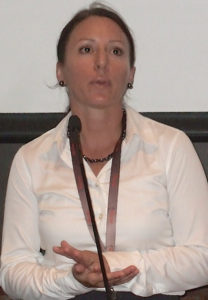
This is part of an ongoing series about health care in the Virgin Islands. Part one looked at the status of the territory’s health care infrastructure.
For some Health Department staff, life is a never-ending battle against bacterial, fungal and viral invaders and the diseases they bear, from those causing short-term discomfort to some that are life-altering or fatal.
The V.I. Health Department’s epidemiologist, Esther Ellis, is on the front line of efforts to anticipate the next disease outbreak and to contain and minimize it as quickly as possible.
With an economy based largely on tourism, the territory draws some 2.9 million visitors a year, Ellis said.
“That is a lot of potential for infectious diseases to be introduced.”
Probably the most common human-to-human communicable disease in the territory is influenza, she said. Tuberculosis is a worry anywhere because “the thing about TB is it’s highly contagious.” So screening for it is common, but typically there are only a “handful” of cases annually.
Still a major concern in the islands is the Human Immunodeficiency Virus and Acquired Immune Deficiency Syndrome, Ellis noted. The V.I. rate of HIV/AIDS infection is close to twice the national average, that is, 618 cases per 100,000 residents, in contrast to the U.S. average of 320 cases per 100,000 people. The V.I. Health Department sees about 25 new cases each year.

Concern over HIV and AIDS (the third stage of HIV infection) and other sexually transmitted diseases is so great that the Health Department has devoted a division almost exclusively to education, prevention and treatment of them. The division of Communicable Disease also handles tuberculosis.
The division lost its director in September 2018, and its surveillance coordinator in November. It is missing some other key personnel, according to the woman who stepped into the breach. Hadiyah Charles joined the Health Department in October 2018 as deputy commissioner. She has been doing double duty as interim director of Communicable Disease.
A St. Thomas native, Charles had been living on the mainland. Beginning as a volunteer, she worked her way into consulting work on Hepatitis C and especially on HIV/AIDS. She noted there have been great strides in combatting HIV.
“It’s now a chronic illness that’s as manageable as diabetes,” she said. With regular treatment, “the quality of your life doesn’t have to be decreased.”
Unfortunately, Charles indicated, that message is not resonating with a lot of people in the Virgin Islands.
“It’s heartbreaking for me … to come back home and see we’re so far behind,” she said.
The division takes advantage of community events, such as the University of the Virgin Islands’ Afternoon on the Green, for outreach to residents. It also visits schools on request, but Charles said a “more robust” educational campaign is needed.
“First we want to staff up,” she said, adding that a new director has been identified and should be in place soon.
“We’re also working with the CDC,” to get some staff on temporary loan. “These positions require specialized credentials.”
While most of the better-known communicable diseases spread from person to person, there are non-human vectors too, and those are the Epidemiology Division’s specialty.
The insidious Aedes aegypti mosquito serves as conduit for an array of infections; most common in the Caribbean region: dengue, chikungunya and zika.
Outbreaks of those illnesses typically follow a cycle of roughly five years. Once the virus is present, it can be passed from an infected human host to an uninfected person via mosquito bite. Zika also can spread directly from human to human through sexual contact, but so far, the primary route seems to involve mosquitos.
Because infected humans develop an immunity, the virus eventually runs out of potential hosts in a given area, so the outbreak dies down – until enough unaffected humans are born or move into the area that it becomes easy to spread again.
Ellis estimates 35 percent of the V.I. population was infected by chikungunya, which made its first appearance in the territory in May 2014 and kept building through 2015. So many people caught the disease that a random survey of households made it “quite easy” to trace it.
Zika, also new to the territory when it surfaced in January 2016,was harder to track. Many people infected by it have no or such slight symptoms they don’t know they are infected, so they don’t seek treatment and they don’t come to the attention of health officials. However, zika can cause severe birth defects if a pregnant woman is infected.
DOH urged pregnant women to be tested for the virus (three times during their terms) and also tested people who presented symptoms. By the time the outbreak ran its course over about a year, the department confirmed 1,032 cases in the territory, including 292 pregnant women. Those numbers, Ellis said, are “just the tip of the iceberg.”
While zika and chikungunya are relatively new in the region, dengue has been making life miserable for significant numbers of residents every few years for decades – at least since the 1970s.
Ellis said there are actually four different strains of dengue, a close cousin of malaria, and two of them – serotype one and serotype two – have been found in the territory.
“We are due for an outbreak” of dengue, Ellis said. The last one came in 2012. “We’ve been looking for it” but last year there were fewer than a handful of cases reported.
Another mosquito-borne illness she has been watching for is yellow fever.
“I’m always looking for that” because it too is spread by the Aedes aegypti mosquito.There is no record of any cases ever in the Virgin Islands, however. And Ellis noted there is a vaccine readily available “if it were to become an issue.”
One positive note from Ellis: the tick that carries Lyme disease is not found in the Virgin Islands.
A good part of an epidemiologist’s work involves “watching” and “looking for” infectious disease. DOH depends on the entire medical community to help with that effort.
Health care providers and facilities are mandated to report any and all cases of infectious diseases. DOH has posted a “Notification of Infectious Disease Form” on its website and provides hard copies of it to providers.
The form lists 65 diseases, separated into three categories, as well as a blank line marked “other.” The 28 diseases in “Category A” include anthrax, cholera and typhoid and should be reported immediately, presumably because of the seriousness of the disease and/or the ease and speed with which it could spread. Category B diseases, which includes several sexually transmitted diseases and three types of hepatitis, should be reported within 48 hours. And Category C diseases, such as mumps, influenza and chicken pox, should be reported “promptly” and at least within 96 hours.
There is no penalty for failure to report, but Ellis said she is confident that the system works.
“We do reach out to providers to remind them of the mandatory requirements and providers have been great working with us on this mutually beneficial effort,” she said. Additionally, “any lab (result) that tests positive for a reportable disease automatically comes to our database.”
The Health Department doesn’t just wait for reports on patients to come in; the epidemiology division actively searches for signs of the development or re-emergence of various infectious diseases.
For instance, the department is currently about two months into a one-year project, testing mongoose and bats for rabies.
“We have never seen a human case here,” Ellis said. And she doesn’t really expect to find it in the wild either, but she’s gathering data in an effort to prevent its introduction in the future. If she can show rabies is not present in the Virgin Islands, the territory can strengthen its case for placing heavy restrictions on importing animals, as Hawaii has done.
The department recently completed a pilot project, testing the water in about 30 home cisterns, looking for pathogens. Another recent project was a survey searching for cases of leptospirosis, a bacterial disease with flu-like symptoms found in domestic and feral animals and transmitted to humans through contaminated fresh water systems.
Early this year, DOH addressed a single case of Legionnaires’ Disease, a severe form of pneumonia – lung inflammation usually caused by infection – typically introduced via AC units, hot tubs, saunas and the like, and which has been known to spread easily in public facilities such as cruise ships or conference centers. The case was linked to a local hotel, which Ellis declined to identify, citing the need to protect the privacy of cooperating entities when there is no danger to the public.
“They worked with us,” she said. “We recommended some guidance” and the hotel took corrective action.
“Our goal is to protect public health,” she added.
Next: Mental health care






Please investigate the chemicals being sprayed in our skies by the U.S. Military, as it is full of heavy metals, and they are affecting our health and our agriculture. Watch two youtube documentaries entitled “What in the World are they Spraying” and “Why in the World are they Spraying.” Enlighten yourself to what the U.S. Military is intentionally doing to all of us.